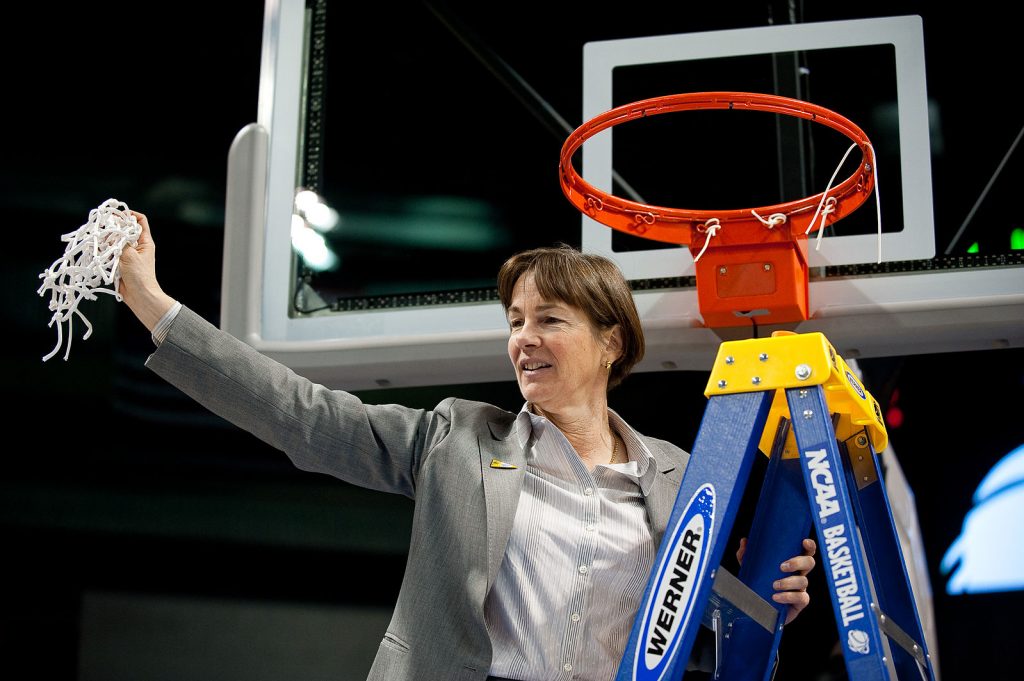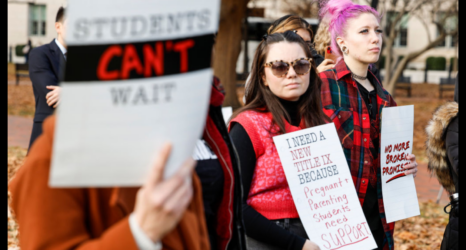
Anyone who pays attention to NCAA women’s sports knows equity for women athletes and coaches is a huge problem—but this year’s women’s basketball tournament really pulled the curtain back in a very public way, according to this year’s national championship-winning Stanford coach Tara VanDerveer.
Because of COVID, both the women’s and men’s tournaments took place in a bubble. The women played in San Antonio, the men in Indianapolis. The tournament inequities came to light when University of Oregon player Sedona Prince created a viral TikTok video showing the men’s state-of-the-art weight room and the women’s single set of free weights.
Oh and it’s women’s history month…. the irony. https://t.co/JD4mFqkwlD
— Sedona Prince (@sedonaprince_) March 19, 2021
VanDerveer said being in the bubble, at first, folks were unaware of the inequities, but once social media kicked in showing them, she says, “You’re just like, ‘Whoa!’” Beyond the weight room, she noted, inequities occurred across the tournament. The women were not able to go outside at all, while the men had a large outside area. The men had better food. Even the swag bags were decidedly different. VanDerveer said what really pushed her over the edge was the difference in COVID testing: The women took antigen tests, but the NCAA provided the men with the “gold standard PCR.”
When the NCAA tried to respond to criticisms, VanDerveer pointed out, they just dug themselves into a deeper hole: At first the NCAA claimed space was the problem for the women’s workout room. Prince then posted a video showing all of the empty space in the room with the paltry weigh set.
Here’s the statement from NCAA VP Lynn Holzman to the Post: pic.twitter.com/OZfNSli223
— Molly Hensley-Clancy (@mollyhc) March 18, 2021
The NCAA has now hired a law firm to investigate the inequities. “I mean, a law firm!” VanDerveer scoffed. “You don’t need a law firm. An 8-year-old could see this.”
VanDerveer Reveals the Importance of Title IX
VanDerveer, who passed Pat Summitt of Tennessee in 2020 as the winningest coach in women’s college basketball history, has long run up against sexism in sports. As a young child before Title IX, VanDerveer fell in love with basketball, but she couldn’t play because her school didn’t have a women’s team. When she was 15, her parents set up a hoop for her in the driveway. She’d go to the park or a gym and try to get into pickup games, but she was rarely welcomed. She said early on she had a “love-hate relationship with basketball” because she didn’t have opportunities to play. When she transferred to Indiana University, she discovered the school had a team. While she loved playing, the treatment of the women’s and men’s teams was vastly different.
“My timing was bad for playing,” she said, “but I think it was good for coaching.” She should know. She’s been coaching for more than 40 years, the last 36 of them at Stanford.
She doesn’t pay attention to records: “I know they’re out there and I know that people keep track of things, but if I had wanted to break that record I never would’ve left Stanford for a whole year and coached the Olympic team, and there goes 30 games right there, you know? If I wanted to set a record, I would’ve stayed maybe at Ohio State and not taken over a team that was 5–23. So, a record was never my goal.”
VanDerveer is quick to turn attention away from herself to her players, assistant coaches and fans. When asked about her place in the growth of women’s basketball over the past 40 years, she responded, “I’m really fortunate to have the opportunities I’ve had. I’ve worked with great administrators. I’ve worked with great assistant coaches, and I’ve coached the absolute best in the world, and I’ve had the opportunities to watch a lot of other great coaches, you know, whether it was with Indiana, or when I was at Idaho, or back at Ohio State, or even here at Stanford.”
Instead, she pointed to the teamwork of basketball as what’s important to her. “You know, basketball’s not an individual sport. I’ve been really, really fortunate in the situations I’ve been in, but I don’t know the number of games that I’ve coached or won or have lost or anything, but I just always feel like I’m interested in watching. I’m watching basketball. I want to improve. I want to get ideas. I love watching the team play when it’s great team basketball.”
Basketball, according to VanDerveer is a kind of ballet, a puzzle of putting a team together, an orchestra. “It’s just so rewarding when your team has a great game, and people are happy, and the fans are all excited. It just beats working for a living.”
VanDerveer often refers to herself as a teacher. She said she herself learned from Pete Newell who coached the men’s team at the University of California (“I won’t hold that against him,” she quipped) and the gold medal-winning 1960 men’s Olympic basketball team. She said when he ran a camp at Stanford, she’d hang around and go to dinner with him to learn more. “He always had a saying that the game of basketball was overcoached and undertaught.”
Instead, he suggested to “spend time teaching fundamentals and working on foot work and all the things that would ultimately help your team be really good.” So VanDerveer said, I just, “I see myself as a teacher. We just have, you know, 32 public exams.”
VanDerveer recognizes the situation for women’s basketball has improved since her childhood and early coaching days. “I think there have always been great players. There have always been great athletes,” she said, “but now women are given more opportunity to train, to play club basketball in the off-season, more access to college basketball, good nutrition. You’re seeing games on television. There’s just so much more exposure. There’s so much more support, so much more opportunity.”
She noted the way social media has also allowed more exposure—recounting how Haley Jones, one of Stanford’s top players, was in the airport just after the Final Four when a pilot recognized her and want to take her picture.
One of the things she identifies as important to the growth of women’s basketball is not only the commitment of the players and coaches to excellence but also the enthusiasm of parents to watch their daughters play. “I think fathers are really key in this whole thing, and mothers obviously too,” she explained. “You know, just saying ‘Hey, you know, my daughter’s as important as my son. We’ve got to have a gym for my daughter. We’ve got to get a bus for my daughter. We’ve got to do these things.’ So, parents, I think, have really been a big driving force to make sure that there are opportunities for girls.”
She admitted Title IX “has been a huge factor in the growth of women’s sports and the growth of women’s basketball and the opportunities that young women and coaches have gotten,” but “Title IX should not have been necessary. We should not have needed Title IX, but the fact of the matter is that we did, and we do.” She’s also concerned about Title IX enforcement—“because otherwise it’s steak for the boys and hot dogs or maybe even just the bun for the girls.”
She says women’s basketball now is much more in the mainstream before. She’ll “talk to the little 8-year-olds and I’ll tell them, I didn’t play on a JV team or I never played on a varsity team; I didn’t have a college scholarship. All the things, the whole litany, and one little girl raises her hand and goes ‘Why not?’ And I’m like, ‘How do you answer that to an 8-year-old?’ And so, I said ‘Can anyone else answer that question?’ And another little 8-year-old raises her hand and goes, ‘Sexism!’”
Financial Sexism in the NCAA
Although some progress has been made, VanDerveer observed, “As the past tournament pointed out, sexism has not been beaten down but, in fact, is alive and well. We have made great progress, but we still have a long way to go.”
She pointed to the ways the NCAA financially rewards teams in the men’s tournament but not the women’s as an example of how sexism persists. The NCAA earns most of its money from tickets and TV rights for the men’s tournament. They pass most of this money back the conferences, and the conferences distribute the winnings among the schools. When a men’s team wins a game in the national tournament, the team earns a “unit” for its conference. This year, each unit was worth $337,141. These units are paid out over six years, making this year’s units worth a total of $1.68 million for the conferences by the time they are paid in full in 2027. This tournament’s winnings for the Pac-12 (the conference for my beloved Oregon State Beavers), which fared very well in the tournament, over six years will be $38,434,074.
You’d think that means the Pac-12 also did very well financially in the women’s tournament where the championship game was two Pac-12 schools—but you’d be wrong. The women earn absolutely nothing for the conferences for their wins.
This creates a perverse incentive for schools to invest heavily in men’s basketball, according to VanDerveer. “There’s no financial gain for a women’s team to do well versus a men’s team. So, there’s a lot more incentive by the NCAA to put money into a men’s program.” The men’s tournament has its own contract with one of the major networks, she noted, while the women’s tournament is lumped in with all the other NCAA sports for TV contracts.
This is just a reminder that sports are a microcosm of the real world.If you think sexism is over, look at the media’s treatment of women in sport.If you think racism is over, look at how (black) athletes are received when they voice their opinions on politics or social justice.
— Imani McGee-Stafford (@imanitrishawn_) October 5, 2019
Many sports aficionados may argue that spending more on men makes sense because men earn more than women. Yet, as VanDerveer reminded, the men’s NCAA tournament began in 1939; the women’s in 1982. “We’re a good 50 years behind them.” Additionally, many men’s leagues have operated at a loss at times. In 1982, the NBA lost millions, and only seven of 23 teams made a profit.
David Berri, professor of economics at Southern Utah University, said, “Men are often regarded as an investment. Women are a cost.”
“I don’t think that you have to have one team good at the expense of another team,” VanDerveer contended. “You can have two great teams, you know, and why shouldn’t we support our men and women athletes equitably? There are things that maybe should be equal. There are things that should be comparable, and there might be things that can be different. Our rules are different. We like our rules. We like the advancing the ball. We like the quarters that we have, and we don’t want to play what the men play, and we should be able to do that. But we don’t like if the men are taking charters and the women are on a bus or commercial. So, I think we have to look at how our resources are being divided up.”
The NCAA’s sexism has been on full display all month.
— Rohin Vaidya (@r2v2_) March 22, 2021
They’ve built one of the biggest brands in all of sports with “March Madness”, yet refuse to use it to market women’s sports. It makes no sense morally nor strategically.
And I know we all saw the weight room videos. https://t.co/hEvBNhe1Yc
New Opportunities for Women Coaches
VanDerveer also observed the lack of opportunity for women coaches. “In men’s basketball the percentage of women that coach men’s basketball is negligible. In women’s basketball, the number of men that coach women’s basketball is like almost 50 percent or more—and so, you know, so right there, a lot of women are cut out of jobs in basketball because there is no opportunity in men’s basketball. You know, there are places that have a commitment to hiring women, and developing women and mentoring women, but a lot of places aren’t set up that way.
“If everything is fair, if it’s a level playing field to coach men and women, I’m all for that. Show that women are given the opportunity to coach men in the same way that men are given the opportunity to coach women, and actually the NBA is starting that a little bit where there are some women getting those opportunities, but because the door basically is shut to all women so only half the jobs are available, then I think it behooves universities to really work hard to hire great female coaches, and on top of that you’ve got some great male coaches who really are developing and mentoring women and have women assistants.”
She was excited that three of the four coaches for the Final Four were women: herself, Adia Barnes of Arizona, and Dawn Staley of South Carolina (the fourth coach was Geno Auriemma of Connecticut)—and two of the three women were Black women. “That I think is really making a statement to our sport,” she said, “that women, Black women can be successful at the highest level, and I think we need those reminders in the world that we live in, reminders that in fact women, Black women are very capable, and I thought it was just great.”
Women should be supporting women in sports, VanDerveer said. “You don’t have to have daughters, you know? Come out and support the high school teams and the college teams. So often I think women are. They’ve got all the work at home. They’ve got children to deal with, and they’re exhausted—but I think that coming to games and watching is something that’s renewing. It can be recharging. We need to support each other.”
She also calls for equity for transgender athletes: “Why do we put more barriers in front of someone that is already dealing with an incredible amount of challenges?”
I asked her what she hopes for women’s basketball 10, 20 years down the road. “I think it would really fun to go to the gym and watch a great game where the game is well-played and well-officiated, not as physical as they’re calling it now. Well-played, well-officiated, you know, great fan support, and I’m going to read about it in the paper the next day. The game’s on television, so if I can’t go, I can watch it.”
She does worry about the impact of new rules like the ability for students to transfer and play right away without sitting out a year or the “Name, Image, and Likeness” (NIL) rule that allows student athletes to earn money for themselves. She wonders if such rules will create greater inequities between the haves and have-nots or if some programs will, in essence, become semi-pro.
I asked about her legacy. She’s not really interested in it. She said what really matters to her are the relationships she’ll have with the players she’s coached—the reward is when 10 or 20 years down the road a player calls her an hour after she has her baby or another one calls dealing with a family issue and asking for her advice.
Her passion for the game and hope for its future are palpable, even over Zoom. “You really lose yourself on the court. You are in a different world. You’re in a very competitive, fun, exciting space, you know? When I see our players out there, they’re not worried about things. They’re playing hard. They’re enjoying their teammates. I think great basketball is, when it’s played as team basketball, it’s like a great orchestra, you know? It’s like listening to a great concert.”
You may also like:





